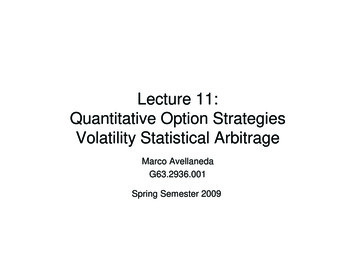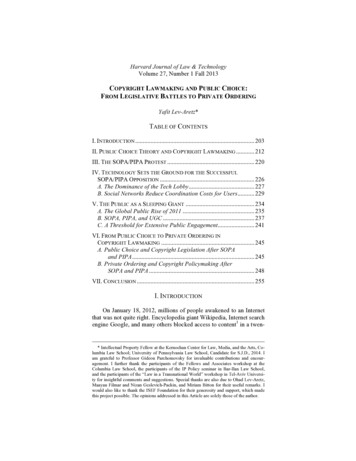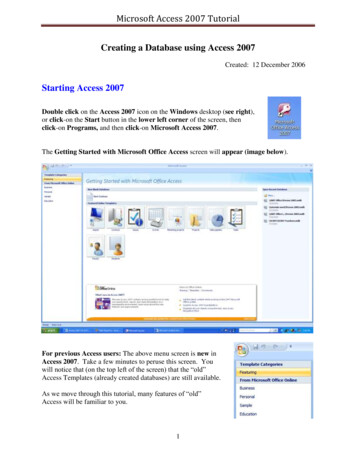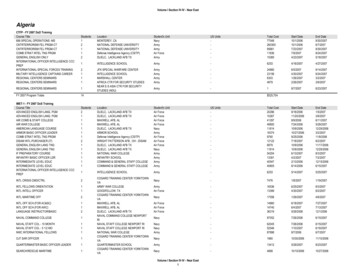
Transcription
CopyrightbyChisung Oh2007
The Dissertation Committee for Chisung Oh Certifies that this is the approvedversion of the following dissertation:TOPIC AND FOCUS CONSTRUCTIONS IN SPOKEN KOREANCommittee:Lisa Green, SupervisorKnud Lambrecht, Co-SupervisorStephen WechslerAnthony WoodburyCinzia Russi
TOPIC AND FOCUS CONSTRUCTIONS IN SPOKEN KOREANbyChisung Oh, B.A.; M.A.DissertationPresented to the Faculty of the Graduate School ofThe University of Texas at Austinin Partial Fulfillmentof the Requirementsfor the Degree ofDoctor of PhilosophyThe University of Texas at AustinMay 2007
AcknowledgementsFirst of all, I would like to thank my committee members, Knud Lambrecht, LisaGreen, Steve Wechsler, Tony Woodbury, and Cinzia Russi, for their valuable advice andencouragement toward the completion of this dissertation. My special thanks go to myadvisor, Dr. Lambrecht, for accepting me as his student, introducing the world ofInformation Structure to me, providing invaluable and insightful comments, and alwaysshowing consideration and kindness to me. I wish to also express my thanks to myfriends in the department of linguistics, Elaine Chun, Dong-Rhin Shin, Q-Wan Kim,Sang-Hoon Park, So-Hee Kim, Seung-Eun Chang, Hyun-Jong Hahm, Jinung Kim,Jihwan Kim, Mi Jang, and Heeyoung Lyu, for so many joyful times that I shared withthem in Austin. My deepest gratitude goes to my wife, Tae-Sook Park, who has heartilysupported me with love, encouragement, and patience, and my son, Hyun-Min, who hasgiven me endless joy and strength even in the most difficult times. Finally, I would like tothank God, who has helped me throughout this dissertation and guided me throughout mylife.iv
TOPIC AND FOCUS CONSTRUCTIONS IN SPOKEN KOREANPublication No.Chisung Oh, Ph.D.The University of Texas at Austin, 2007Supervisors:Lisa GreenKnud LambrechtThis study discusses topic and focus constructions in spoken Korean within theframework of information structure. Information structure is a part of grammar that dealswith the relation between linguistic forms and the mental states of speakers and hearers.Since the different formal realizations of topic and focus constructions in Korean are dueto differences in speakers’ assumptions about the mental states of hearers, research onKorean topic and focus constructions falls under the proper domain of informationstructure.Five different topic constructions in Korean are reviewed and their discoursecontexts are analyzed; zero pronouns, bare NPs, and right-dislocated NPs are generallyused for discourse-active topic referents, and the maliya-construction and nun-markedNPs are generally used for topic referents that are not discourse-active. Sometimes, activetopic referents are also marked with –nun when the topic referents have more salienttopics already established in the discourse or speakers are considering potentialalternatives to the active topic referents. Topics are divided into ratified and unratifiedv
topics according to whether their status as topics is assumed to be taken for granted byhearers. Among the five topic constructions in Korean, zero pronouns, bare NPs andright-dislocated NPs express ratified topics, while the maliya-construction and nunmarked topics express unratified topics.The marker –ka, which has been long regarded as a subject indicator, isreanalyzed, and it is suggested that –ka marks not only the subject but also argumentfocus and sentence focus. Accessible or active referents can sometimes be marked with–ka, constituting sentence-focus constructions. In those constructions, the propositionalcontent of the sentences expresses some unexpected or surprising event. Also, frequentoccurrences of the maker –ka in presupposed subordinate clauses are examined, and it issuggested that –ka can be used as a mere subject indicator, losing its function ofindicating focus in presupposed clauses with topic-comment construals, in which there isno actual focus.vi
Table of ContentsChapter 1 Introduction. 11.1 Overview and Data . 11.2 Organization . 4Chapter 2 Theoretical Background: Lambrecht (1994) . 62.1 Information Structure. 62.2 Assertion and Presupposition . 72.2.1 Pragmatic Accommodation of Presuppositional Structure. 92.3 Three Types of Focus Structure. 112.4 Definition of Topic . 182.5 The Mental Representations of Discourse Referents and the TopicAcceptability Scale . 212.5.1 Identifiability. 212.5.2 Activation . 222.5.3 The Topic Acceptability Scale. 24Chapter 3 Previous Approaches to –nun and –ka . 273.1 Previous Approaches to –nun. 283.1.1 The Division of nun-Marked Topics into Contrastive and NonContrastive Topics. 283.1.2 -nun as a Discourse-Topic-Establishing Marker. 363.2 Previous Approaches to –ka . 393.2.1 Focus-Neutral -ka. 393.2.2 –ka as a Continuing-Topic Marker. 433.2.3 Scrambling as an Indicator of Argument Focus. 45Chapter 4 Topic Constructions in Korean . 494.1 Zero Pronouns . 494.1.1 Discourse-Initial Zero Pronouns . 564.2 Bare NPs. 584.3 Topics with –nun . 63vii
4.3.1 Inactive Topics. 644.3.2 Accessible Topics. 714.3.3 Active Topics with a More Salient Topic Already Established in theDiscourse . 744.3.4 Active Topics without a More Salient Topic in the Discourse. 804.4 The maliya-Construction. 864.5 Right-Dislocation. 954.6 Comparison of the Different Topic Constructions in Korean: Ratified andUnratified Topics .1024.6.1 Ratified and Unratified Topics in English and French.1034.6.2 Ratified and Unratified Topics in Korean: Summary .108Chapter 5 Focus Constructions in Korean: -ka as a Focus Marker.1145.1 Argument-Focus Constructions: -ka as an Argument-Focus Marker.1155.2 Sentence-Focus Constructions: -ka as a Sentence-Focus Marker .1185.3 Accessible or Active Referents with the Marker –ka: Unexpected andSurprising Events.1265.4 -ka in Subordinate Clauses.1335.4.1 –ka in Asserted Subordinate Clauses .1345.4.2 –ka in Presupposed Subordinate Clauses .1365.4.2.1 Three Focus Structures in Presupposed Clauses .1365.4.2.2 –ka as a Mere Subject Indicator in Presupposed Clauses withTopic-Comment Construals .144Chapter 6 Summary and Conclusion.153References.156Vita . .161viii
Chapter 1 Introduction1.1 OVERVIEW AND DATAIn Korean, subjects can be expressed with four different forms: zero pronouns,bare NPs,1 nun/un2-marked NPs, and i/ka3-marked NPs. The following four sentences,thus, may express the same proposition “a person named John is studying at UT,” thoughtheir subjects have different forms:(1) a. JohnUT-eyse kongpwuhayyo.UT-atstudy‘John is studying at UT.’b. John-iUT-eysekongpwuhayyo.c. John-un UT-eysekongpwuhayyo.d. Økongpwuhayyo.UT-eyseThe fact that one and the same proposition can be expressed by sentences with differentforms of subjects has generated much interest among researchers in Korean linguistics,and it has been a source of much controversy and debate (e.g. see Choi (1984)). Thisdissertation investigates various issues related to differently marked Korean subject NPswithin the framework of “information structure” (Lambrecht 1994), focusing primarilyon their communicative functions. Drawing on Lambrecht’s (1994) framework, which1 Bare NPs in this dissertation are defined as NPs to which no marker (-nun/-un, -i/-ka) is attached. So insubject position, they are realized as NPs with neither –nun/-un nor –i/-ka. However, they can havedeterminers, possessive markers or other modifiers.2 -nun/-un are allomorphs of one morpheme; if the preceding noun ends in a consonant, -un is attached,otherwise –nun is attached.3 -i/-ka are allomorphs of one morpheme; if the preceding noun ends in a consonant, -i is attached,otherwise –ka is attached.1
assumes three types of focus structure (predicate-focus, argument-focus, and sentencefocus structures), I will show that the four different formal markings of Korean subjectsconstitute different topic and focus constructions in Korean: zero pronouns, bare NPs,and nun/un-marked NPs constitute topic constructions, and i/ka-marked NPs constitutefocus constructions. This dissertation also examines other topic constructions (i.e. themaliya-construction and right-dislocation) and identifies their discourse contexts.It has been widely accepted that –nun/-un (henceforth -nun) is a topic marker inKorean, marking either contrastive or non-contrastive topics. In other words, the basicassumption has been that NPs marked by –nun can be divided into two distinct categoriesbased on the function of this marker. In this dissertation, however, I will compare varioustopic constructions in Korean and claim that both functions of –nun should be unifiedunder the notion of “unratified topics.” Also, it will be shown that the contrastivenessrelated to the Korean topic marker –nun is a gradient notion: referents marked by –nuncan have various degrees of contrastiveness depending on the discourse context. Thecomparison of topic constructions will further reveal that there is a formal differencebetween “ratified topics” and “unratified topics” in Korean as in French and English(Lambrecht 1994).The nun-marked NPs and other topic NPs discussed in this dissertation are mainlyin subject position. Unlike bare NPs in subject position, the use of which is generallydetermined pragmatically (i.e. determined by pragmatic functions and communicativeneeds), it has been pointed out by Lee & Thompson (1989) that the use of bare NPs inobject position is often affected by non-pragmatic factors such as incorporation andconventional uses; according to Lee & Thompson, bare NPs are often allowed in objectposition when they are closely linked with their predicates forming a single concept, andthere are certain expressions in which the forms containing bare-NP objects and verbs are2
fixed by convention. Thus, determining the exact communicative function of bare NPs inobject position and comparing them with other topic expressions may be problematic.Though I will mainly discuss topics in subject position, it should be noted that nunmarked topics and other topic expressions are also available in object position.4Korean –i/-ka (henceforth -ka), which has long been regarded as a subjectindicator, will be reanalyzed in this dissertation. On the basis of spoken Korean data, itwill be shown that –ka marks not only the subject function but also both argument andsentence focus in Korean. Though -ka is a focus marker in Korean, the data will alsoshow that it is sometimes attached to accessible or active referents in sentence-focusstructures, in which case the proposition of the sentence describes some unexpected orsurprising event. Also, the frequent occurrences of the marker -ka in presupposedsubordinate clauses will be reviewed, and it will be proposed that -ka can be used fornon-focal subjects merely as a subject indicator in some presupposed clauses.The spoken Korean data which I use in this dissertation are mainly collected fromtwo Korean television dramas: Kaultonghwa ‘Autumn Story,’ which aired in 2000 andPwuhwal ‘Rebirth,’ which aired in 2005. I choose these two dramas because they containnatural and acceptable spoken Korean, representing present-day Seoul dialect. I alsosupplement the data from these two shows with sentences I have created based on mynative-speaker intuition, which sometimes show some pragmatically odd discoursesituations. I review six episodes, or about five and a half hours of Kaultonghwa, and fiveepisodes, or about five hours of Pwuhwal. All of the data from the two dramas are eithertranscribed by me or taken from the transcription provided by the broadcasting company(KBS)5 that aired both of the dramas.45Lee (1999) shows that objects and other grammatical functions can also be marked with –nun in Korean.I took the data from the website of KBS (www.kbs.co.kr).3
1.2 ORGANIZATIONThis dissertation is organized as follows:In chapter 2, I will outline the basic theoretical background of this dissertation,namely Lambrecht’s (1994) theory of “information structure.” In addition to introducingkey concepts, such as “information” and “focus,” among others, I will clarify thedifference between the notions “presupposition” and “assertion.” The three differentfocus structures (i.e. predicate-focus, argument-focus, and sentence-focus structures) ofEnglish and French will be introduced, and it will be shown that English and Frenchexploit different formal markings to express their focus structures. I will also provide adefinition of “topic,” based on the “aboutness” relation, and I will discuss peechparticipants(e.g.identifiable/unidentifiable, active/inactive, and accessible).Chapter 3 examines previous approaches to Korean –nun and -ka. First, it will benoted that there has been little work in the Korean literature that compares various topicconstructions in Korean, as I do in chapter 4. Then, I will introduce five major previousapproaches, which I have entitled “the division of nun-marked topics into contrastive andnon-contrastive topics,” “–nun as a discourse-topic-establishing marker,” “focus-neutral-ka,” “–ka as a continuing-topic marker,” and “scrambling as an indicator of argumentfocus.” After reviewing those five approaches, I will point out that each of them has itsown problems.In chapter 4, I will describe the various topic constructions in Korean (zeropronouns, bare NPs, nun-marked NPs, the maliya-construction and right-dislocation), andI will reveal in what discourse contexts each of the Korean topic constructions is used. Bycomparing those topic constructions, I will propose that zero pronouns, bare NPs, andright-dislocation constructions are used for different kinds of “ratified topics” and that4
nun-marked NPs and the maliya-construction are used for different kinds of “unratifiedtopics” in Korean.In chapter 5, my investigation will show that -ka functions as a focus marker inKorean, indicating both argument-focus and sentence-focus structures.5
Chapter 2 Theoretical Background: Lambrecht (1994)2.1 INFORMATION STRUCTUREMy analyses of the four different subject NP forms and the related topic and focusconstructions in Korean is largely based on the theory of information structure presentedin Lambrecht (1994). According to Lambrecht, the theory of information structurepursues the relation between linguistic forms and the mental states of speakers andhearers. More specifically, it deals with how the speaker’s assumptions about the mentalstates of the hearer affect the linguistic forms that the speaker actually produces. Aspeaker uses different sentence forms which have the same propositional content,depending on his assumptions about a hearer’s mental states. The grammatical meanswhich are used for this purpose are prosody, grammatical markers, ordering ofconstituents, complex grammatical constructions, etc.Let us look at the definition of information structure proposed by Lambrecht:That component of sentence grammar in which propositions as conceptualrepresentations of states of affairs are paired with lexicogrammatical structures inaccordance with the mental states of interlocutors who use and interpret thesestructures as units of information in given discourse contexts. (1994: 5)One important proviso in the above definition is that even though informationstructure is concerned with assumptions about the mental states of the interlocutors, theassumptions are relevant only if they have some grammatical correlates in sentencestructure. So, the speakers’ assumptions which are not reflected in “lexicogrammaticalstructure” are not considered to be in the proper domain of information structure.6
According to Lambrecht (1994:6), the most important notions of informationstructures are i) presupposition and assertion, “which have to do with the structuring ofpropositions into portions which a speaker assumes an addressee already knows or doesnot know,” ii) identifiability and activation, “which have to do with a speaker’sassumption about the statuses of the mental representations of discourse referents in theaddressee’s mind at the time of an utterance,” and iii) topic and focus, “which have to dowith a speaker’s assessment of the relative predictability vs. unpredictability of therelations between propositions and their elements in given discourse situations.” All ofthe notions mentioned above are related to a speaker’s assumptions about a hearer’smental states with respect to propositions or discourse referents which are conveyed bythe speaker’s utterance, and they are formally reflected in sentences. I will discuss thosenotions in later sections, and show how they have formal reflections in English, Frenchand Korean.As we shall see later, a speaker’s choice of the four different subject forms, whichare actually realizations of different topic and focus constructions in Korean, is alsoaffected by his assumptions about a hearer’s mental states. So, we may say that the fourdifferent forms are in the proper domain of information structure and that they are thephenomena which cannot be fully understood and explained without the theory ofinformation structure.2.2 ASSERTION AND PRESUPPOSITIONAccording to Lambrecht (1994:52), when a speaker utters a sentence, it usuallycontains two types of information: presupposition and assertion. Presupposition is a typeof information that is already shared by a speaker and a hearer at the time of utterance7
(old information), and assertion is information that is added to the hearer’s mental worldas a result of the utterance (new information). The following definitions of presuppositionand assertion by Lambrecht will give us a clear picture of them:PRAGMATIC PRESUPPOSITION: The set of propositions lexicogrammaticallyevoked in a sentence which the speaker assumes the hearer already knows or isready to take for granted at the time the sentence is utteredPRAGMATIC ASSERTION: The proposition expressed by a sentence which thehearer is expected to know or take for granted as a result of hearing the sentenceuttered. (1994: 52)In the above definitions, we have to note some important points that should be madeclear. First, both presupposition and assertion are propositions. Following Dahl (1976),Lambrecht argues that what is stored in or conveyed to a hearer’s mental world as objectsof his knowledge or belief is propositional information. In other words, when a speakersays something to change the hearer’s mental picture, what he tries to convey as newinformation is a proposition.Second, we need to pay attention to the word “pragmatic.” Lambrecht emphasizesthe difference between pragmatic presupposition and logical or semantic presupposition;the former has to do with the speaker’s assumption about the information status ofpropositions in utterance contexts, and the latter has to do with the logical or semanticrelations between sentences. Thus the pragmatic presupposition is a relation between aperson and a proposition, while the semantic presupposition is a relation betweenpropositions (Stalnaker 1973). Lambrecht also emphasizes that it is the pragmatic notionof presupposition that is relevant for information-structure analysis.Third, presuppositions are lexicogrammatically evoked in a sentence. Unlike thenotion of presupposition found in many discussions on pragmatics (e.g. Kempson 1975)8
not every proposition shared between the speaker and the hearer counts aspresupposition; only those shared propositions that have a lexicogrammaticalmanifestation in the sentence count as pragmatic presupposition in the theory ofinformation structure.2.2.1 Pragmatic Accommodation of Presuppositional StructureAs described above, pragmatic presupposition is a proposition which is lexicogrammatically evoked, and this entails that presupposition is not only a matter of themental states of speakers and hearers but also a matter of grammar and lexicon. In otherwords, certain grammatical constructions are appropriately used only in certainpresuppositional situations. According to Lambrecht, those constructions havepresuppositional structures, which are inherent properties of linguistic expressions. In anormal conversation, if a speaker utters a linguistic expression which has a certainpresuppositional structure, it is usually assumed that the discourse situation associatedwith the presuppositional structure is shared by the speaker and the addressee. Forexample, many sentence-initial English time adverbial clauses (e.g. those starting withwhen, after, before etc.) have presuppositional structures that tell us that the propositionalcontent of the subordinate clauses is pragmatically presupposed. So, a time adverbialclause is used usually when the propositional content of the subordinate clause ispresupposed in the discourse situation.However, since the presuppositional structure is an inherent property of alinguistic expression, a speaker can use a presuppositional structure to create apresupposition, even though the speaker does not assume the presupposition to be knownto the addressee. By using a presuppositional structure, the speaker acts as if he assumesthat the addressee knows the presupposition, and the addressee responds to this by9
supplying the required presupposition and by acting as if he indeed knew it. Finally, thisnewly created presupposition becomes a part of the pragmatic presuppositions shared bythe speaker and the addressee in the conversation. The whole process of the pragmaticaccommodation of presuppositional structure stated above is well formulated in thefollowing “rule of accommodation for presupposition” by Lewis (1979):If at time t something is said that requires presupposition P to be acceptable, andif P is not presupposed just before t, then – ceteris paribus and within certainlimits – presupposition P comes into existence at t. (1979:172)Let us take one example from Lambrecht (1994) to show how the accommodationhappens. Suppose a story writer begins his story with the following sentence:(2) Before I moved to Switzerland I had never seen a Rolls Royce. (1994:68)Since the sentence in (2) contains the adverbial before-clause, it is usually assumed thatthe proposition of the subordinate clause is known to the addressee. However, since (2) isthe first sentence of the story, it cannot be expected for the addressee to know theproposition. Nevertheless, the sentence is acceptable and there is no difficulty for theaddressee to understand it. The rule of accommodation for presupposition proposed byLewis explains the naturalness of the sentence: the speaker creates a presupposition withthe before-clause and a cooperative addressee will act as if the proposition is already partof his knowledge.10
2.3 THREE TYPES OF FOCUS STRUCTUREIn order to fully understand in what discourse contexts different topic and focusconstructions in Korean (including the four differently marked subject NPs) occur, weshould first distinguish three different focus structure types (Lambrecht 1994:221-238):predicate-focus, argument-focus, and sentence-focus structure. These different focusstructure types, as their names indicate, are determined by which part of the propositionof an uttered sentence is focal. Since the focus structure types crucially involve the notionof “focus,” let us give the definition of focus first. The following is the definition of focusgiven by Lambrecht, which is adopted in this dissertation:The semantic component of a pragmatically structured proposition whereby theassertion differs from the presupposition. (1994:213)It should be noted that the above definition defines the nature of focus as “relational.”That is, whether or not a denotatum is focal is determined relative to the proposition of anuttered sentence but not by its own pragmatic properties. Also, according to thedefinition, focus is a semantico-pragmatic notion rather than a syntactic one; the notion isdefined on the pragmatically structured proposition but not on a syntactic domain, andsince the focus is a portion of a proposition, it cannot be a syntactic constituent. Thisdefinition of focus, thus, distinguishes itself from the “segmentation” view 6 ofinformation (Jackendoff 1972; Selkirk 1984), in which the information conveyed by asentence is viewed as segmented into old and new information (new informationcorresponds to focus in this view), which are identified with syntactic constituents.6See Lambrecht (1994: 208-212), for more discussion and his criticism of the segmentation view.11
Lambrecht calls the syntactic realization of a focus “focus domain,” emphasizingthat “the pragmatic category must be sharply distinguished from its grammaticalrealization in the sentence.” To understand his definition completely, we have to clarifythe distinction between assertion and presupposition. As mentioned in the previoussection, an assertion is a proposition expected to be known or taken for granted by ahearer as a result of hearing a sentence uttered, while the presupposition is the set ofpropositions a speaker assumes to be known or taken for granted by the hearer at the timethe sentence is uttered. So, we can divide the pragmatically structured proposition of anuttered sentence into two portions: one which is already part of the presupposition and theother which does not belong to the presupposition. This latter portion of the proposition,which makes the assertion different from the presupposition, is the focus. In thepredicate-focus structure, which is also called topic-comment structure, the predicate isthe focus and the subject is in the presupposition. In the argument-focus structure, anopen proposition is presupposed and the missing argument for the open proposition is thefocus, and in the sentence-focus structure, the focus covers the entire proposition: boththe subject and the predicate.These three different focus structures have different formal realizations in Englishand French as illustrated in the following examples from Lambrecht (1994:223):(3) PREDICATE-FOCUS STRUCTUREA: What happened to your car?B: a. My car/It broke DOWN.7b. (Ma voiture) elle est en PANNE.7Small capitals indicate the locus of the sentence accent.12
(4) ARGUMENT-FOCUS STRUCTUREA: I heard your motorcycle broke down?B: a. My CAR broke down.b. C’est ma VOITURE qui est en panne.(5) SENTENCE-FOCUS STRUCTUREA: What happened?B: a. My CAR broke down.b. J’ai ma VOITURE qui est en PANNE.In the predicate-focus structure in (3B), it is clear that the subject in B’s answer isin the domain of the presupposition, since A has already asked some information aboutB’s car in his question. Thus, the presupposition in B’s answer is that A wants to havesome comment about B’s car, i.e. B’s car is the topic8 of the sentence, and the assertionis that the predicate “broke down” is the comment for B’s car. So, the focus whereby theassertion differs from the presupposition is the predicate “broke down,” and the focusdomain is the VP. The information structure of the sentence is represented in (6)(6) Sentence:8My car broke DOWN.Presupposition:“Speaker’s car is a topic for comment x”Assertion:“x broke down”Focus:“broke down”Focus domain:VP(Lambrecht 1994: 226)The definition of topic will be given in detail in section 2.4 below.13
If we look at how the predicate-focus structure is formally realized, we notice that in bothEnglish (3Ba) and French (3Bb), the topical
friends in the department of linguistics, Elaine Chun, Dong-Rhin Shin, Q-Wan Kim, Sang-Hoon Park, So-Hee Kim, Seung-Eun Chang, Hyun-Jong Hahm, Jinung Kim, Jihwan Kim, Mi Jang, and Heeyoung Lyu, for so many joyful times that I shared with them in Austin. My deepest gratitude goes to my wife, Tae-Sook Park, who has heartily










